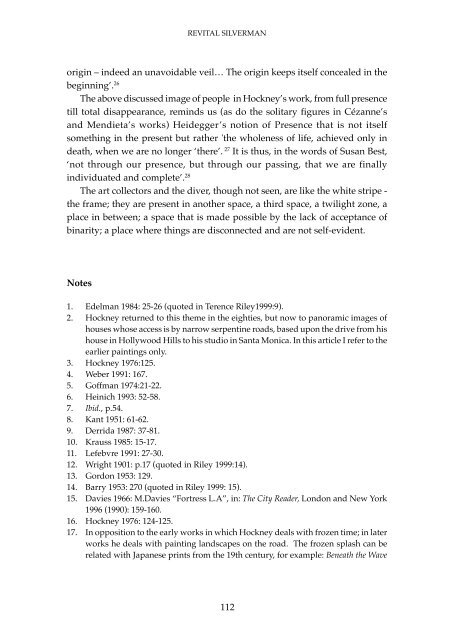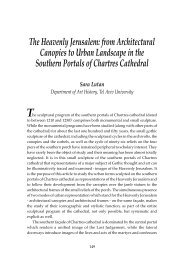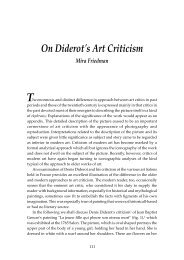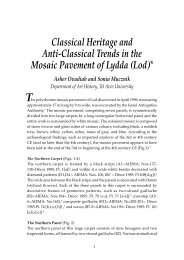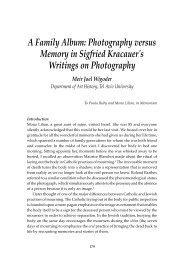The Non-presence of People in David Hockney's Paintings of ...
The Non-presence of People in David Hockney's Paintings of ...
The Non-presence of People in David Hockney's Paintings of ...
Create successful ePaper yourself
Turn your PDF publications into a flip-book with our unique Google optimized e-Paper software.
REVITAL SILVERMAN<br />
orig<strong>in</strong> – <strong>in</strong>deed an unavoidable veil… <strong>The</strong> orig<strong>in</strong> keeps itself concealed <strong>in</strong> the<br />
beg<strong>in</strong>n<strong>in</strong>g’. 26<br />
<strong>The</strong> above discussed image <strong>of</strong> people <strong>in</strong> Hockney’s work, from full <strong>presence</strong><br />
till total disappearance, rem<strong>in</strong>ds us (as do the solitary figures <strong>in</strong> Cézanne’s<br />
and Mendieta’s works) Heidegger’s notion <strong>of</strong> Presence that is not itself<br />
someth<strong>in</strong>g <strong>in</strong> the present but rather 'the wholeness <strong>of</strong> life, achieved only <strong>in</strong><br />
death, when we are no longer ‘there’. 27 It is thus, <strong>in</strong> the words <strong>of</strong> Susan Best,<br />
‘not through our <strong>presence</strong>, but through our pass<strong>in</strong>g, that we are f<strong>in</strong>ally<br />
<strong>in</strong>dividuated and complete’. 28<br />
<strong>The</strong> art collectors and the diver, though not seen, are like the white stripe -<br />
the frame; they are present <strong>in</strong> another space, a third space, a twilight zone, a<br />
place <strong>in</strong> between; a space that is made possible by the lack <strong>of</strong> acceptance <strong>of</strong><br />
b<strong>in</strong>arity; a place where th<strong>in</strong>gs are disconnected and are not self-evident.<br />
Notes<br />
1. Edelman 1984: 25-26 (quoted <strong>in</strong> Terence Riley1999:9).<br />
2. Hockney returned to this theme <strong>in</strong> the eighties, but now to panoramic images <strong>of</strong><br />
houses whose access is by narrow serpent<strong>in</strong>e roads, based upon the drive from his<br />
house <strong>in</strong> Hollywood Hills to his studio <strong>in</strong> Santa Monica. In this article I refer to the<br />
earlier pa<strong>in</strong>t<strong>in</strong>gs only.<br />
3. Hockney 1976:125.<br />
4. Weber 1991: 167.<br />
5. G<strong>of</strong>fman 1974:21-22.<br />
6. He<strong>in</strong>ich 1993: 52-58.<br />
7. Ibid., p.54.<br />
8. Kant 1951: 61-62.<br />
9. Derrida 1987: 37-81.<br />
10. Krauss 1985: 15-17.<br />
11. Lefebvre 1991: 27-30.<br />
12. Wright 1901: p.17 (quoted <strong>in</strong> Riley 1999:14).<br />
13. Gordon 1953: 129.<br />
14. Barry 1953: 270 (quoted <strong>in</strong> Riley 1999: 15).<br />
15. Davies 1966: M.Davies “Fortress L.A”, <strong>in</strong>: <strong>The</strong> City Reader, London and New York<br />
1996 (1990): 159-160.<br />
16. Hockney 1976: 124-125.<br />
17. In opposition to the early works <strong>in</strong> which Hockney deals with frozen time; <strong>in</strong> later<br />
works he deals with pa<strong>in</strong>t<strong>in</strong>g landscapes on the road. <strong>The</strong> frozen splash can be<br />
related with Japanese pr<strong>in</strong>ts from the 19th century, for example: Beneath the Wave<br />
112


